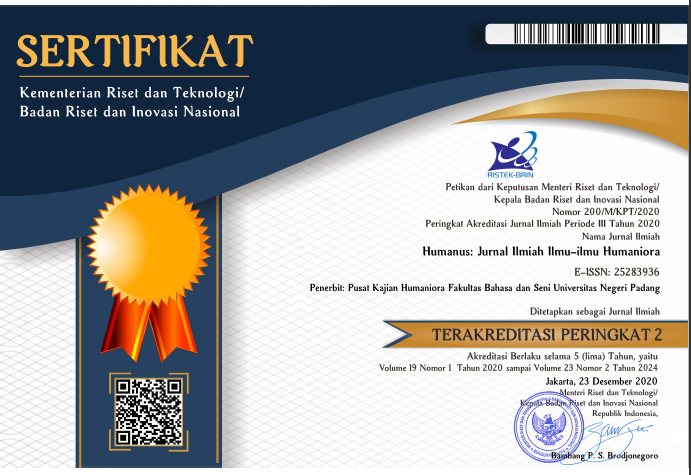ADJACENCY PAIRS AS UTTERED IN THE CONVERSATIONS OF SOFIA COPPOLA’S LOST IN TRANSLATION MOVIE SCRIPT
 ),
), (1) State Islamic Institute of Kerinci, Indonesia
 Corresponding Author
Corresponding Author
Copyright (c) 2018 Humanus
DOI : https://doi.org/10.24036/humanus.v17i1.8050
Full Text:
 Language : en
Language : en
Abstract
This paper contains a discussion of the structures of Adjacency Pairs as uttered in the conversations of Lost in Translation movie script in terms of conversational analysis study. A conversation consists of at least two turns and two utterances which contain two acts of speech. Such utterances consisting of a first pair part which is followed by a second pair part form adjacent pairs which can be either preferred or dispreferred responses. Adjacency Pairs in term of preferred responses include twenty eight structures, while those in term of dispreferred responses include fourteen structures. The choice of a variety of responses is influenced by habits and cultures through which speakers convey meaning. Different habits and cultures of the speakers allow them to produce particular utterances which contain particular acts of speech. Subjectivity and intention influence the second speaker to respond the first speaker’s act based on what is intended. This is psychologically subjective rather than illogical. The complex structures of Adjacency Pairs are also caused by noises, unclear voices, and complex sentence patterns. The variations of adjacent pairs are basically contextual and situational which imply that Adjacency Pairs emerge in different structures within different contexts of conversations.
Keywords: Adjacency pairs, turn taking, conversation, speech act, utterance
PASANGAN BERDAMPINGAN PADA UJARAN PERCAKAPAN DI NASKAH FILM LOST IN TRANSLATION KARYA SOFIA COPPOLA
Abstrak
Artikel ini berisi pembahasan tentang pola Pasangan Berdampingan berdasarkan ujaran percakapan pada naskah filem Lost in Translation melalui teori analisis percakapan. Percakapan terdiri atas dua giliran and ujaran yang mengandung dua tindak tutur. Ujaran-ujaran yang terdiri atas bagian berdampingan pertama dan diikuti bagian berdampingan kedua sehingga membentuk pasangan berdampingan baik dengan respon yang diharapkan maupun yang tidak diharapkan. Pasangan Berdampingan khususnya respon yang diharapkan terdiri atas dua puluh delapan pola berdampingan, sedangkan respon yang tidak diharapkan terdiri atas empat belas pola. Ragam respon dapat dipengaruhi oleh kebiasaan dan budaya pembicara pada saat berbicara. Perbedaan kebiasaan dan budaya mempengaruhi pembicara dalam membuat ujaran yang mengandung tindak tutur tertentu. Subjektifitas dan intensi juga dapat mempengaruhi respon pembicara kedua terhadap tindak tutur pembicara pertama. Hal ini bersifat subjektif namun bukan tidak logis. Pola yang komplels pada Pasangan Berdampingan juga dapat dipengaruhi oleh suasana ribut, suara yang kurang jelas, dan struktur kalimat yang kompleks. Ragam pola tersebut pada dasarnya bersifat kontekstual dan situasional yang berarti bahwa pola Pasangan Berdampingan akan berbeda pada konteks percakapan yang berbeda.
Kata kunci: Pasangan berdampingan, giliran berbicara, konversasi, tindak tutur, ujaran
Keywords
References
Adams, K.L. (1981). Question/answer adjacency pairs in a performance appraisal interview. Journal of Applied Communication Research, 9(2), 72-84, DOI: 10.1080/00909888109360292
Baiat, G.E., Coler, M., Pullen, M., Tienkouw, S., & Hunyadi, L. (2013). Multimodal analysis of “well” as a discourse marker in conversation: A pilot study. Paper presented at 4th IEEE International Conference on Cognitive Infocommunications, Budapest, Hungary.
Berglund, T.O. (2009). disrupted turn adjacency and coherence maintanence in instant messaging conversations. Language@Internet, 6, 1-25.
Coates, J. (2004). Women, men, and language: A sociolinguistic account of gender differences in language (2nd ed.). London, UK: Longman.
Coulthard, M. (1985). An introduction to discourse analysis. New York, NY: Routledge.
Cui, Y. (2016). Adjacency pairs and interactive consciousness in Virginia Woolf's novels. Style, 50(2), 203-222.
Duncan, S. (1972). Some signals and rules for taking speaking turns in conversations. Journal of personality and social psychology, 23(2), 283.
Fauzia, R. (2015). A pragmatic analysis of the adjacency pairs in the modern script of Franco Zeffirelli’s Romeo and Juliet Movie. Unpublished thesis. Yogyakarta: Faculty of Language and Arts of Yogyakarta States University.
Fetzer, A. (2014). Conceptualising discourse. In Schneider, K.P and Barron, A., Pragmatics of discourse (pp. 35-62). Berlin: De Gruyter Mouton.
Fiske, S. T. (2000). Stereotyping, prejudice, and discrimination at the Seam between the centuries: Evolution, Culture, Mind, and Brain. European Journal of Social Psychology, 30, 299-322.
Fitriana, G.A. (2013). Adjacency pairs analysis in "Red Riding Hood's" movie. Unpublished thesis. Surakarta: Faculty of Teacher Training and Education of Muhammadiyah University of Surakarta.
Garcia, A. (1991). Dispute resolution without disputing: How the interactional organization of mediation hearings minimizes argument. American Sociological Review, 818-835.
Hagoort, P., & Meyer, A. S. (2013). What belongs together goes together: The speaker-hearer perspective. a Commentary on Macdonald’s PDC Account. Frontiers in Psychology, 4, 228. http://doi.org/10.3389/fpsyg.2013.00228
Hasan, F. (2015). Adjacency pairs in "Knight and Day" movie. Unpublished thesis. Surabaya: Faculty of Letters and Humanities of UIN Sunan Ampel Surabaya.
Hasanuddin WS. (2016). The intangible cultural heritage of Minangkabau traditional expressions: The local wisdom of the society in advising and noble advicing. Humanus, 15(2), 131-141.
Hermansyah, M. (2014). Preferred and dispreferred responses in the dialogues of junior high school's electronic English books. Surabaya: Faculty of Humanities of Airlangga University.
Isgianto, L. (2016). The adjacency pairs analysis on ‘Six Minutes English’ conversation script of BBC Learning English: A Study of Discourse Analysis. Paper presented at International Seminar Prasasti III: Current Research in Linguistics, Solo.
Jalilifar, A.R., & Dinarvand, R. (2013). An analysis of Iranian EFL Learners’ dis-preferred responses in interactional discourse. The Journal of Teaching Language Skills (JTLS), 5(1), 19-44.
Levinson, S.C. (1983). Pragmatics. Cambridge: Cambridge University Press.
Mansouri, S. & Mirsaeedi, A. (2012). Application of Levinson concept of dispreferred seconds to the review of Iranian high school English textbooks. Paper presented at International Conference on Economics Marketing and Management, 28, Singapore.
Oreström, B. (1983). Turn-taking in English conversation (66). Krieger Pub Co.
Permatasari, I., & Listiyanti. (2017). Adjacency pairs in drama script “Teen Angel” by D.M Larson. Ahmad Dahlan Journal of English Studies (ADJES), 4(2), 13-20.
Pomerantz, A. (1984). Agreeing and disagreeing with assessments: Some features of preferred/dispreferred turn shapes. In M. Atkinson & J. Heritage (Eds.), Structures of social action: Studies in conversation analysis (pp. 57-101). Cambridge: Cambridge University Press.
Pomerantz, A., & Pehr. B.J. (2000). Conversation analysis: An approach to the study of social action as sense making practices. London: Sage Publication Ltd.
Rendle-Short, J. (2015). Dispreferred responses when texting: Delaying that ‘No’ response. Discourse & Communication, 9(6), 643-661.
Richards, J.C., &, Schmidt, R.W. (1985). Longman dictionary of applied linguistics. London: Longman.
Sacks, H., Schegloff, E.A., & Jefferson, G. (1974). A simplest systematic for the organization of turn-taking for conversation. Language, 50(4), 696-735.
Sacks, H. (1987). On the preferences for agreement and contiguity in sequences in conversation. In G. Button & J.R.E. Lee (Eds.), Talk and social organization (pp. 54-69). Philadelphia, PA: Multilingual Matters.
Schegloff, E.A., and Sacks, H. (1973). Openings and closings. Semiotica, 7, 289-327.
Schegloff, E.A. (2007). Sequence organization in interaction: A primer in conversation analysis. Cambridge: Cambridge University Press.
Schegloff, E. A., & Lerner, G. H. (2009). Beginning to respond: Well-prefaced responses to wh-questions. Research On Language And Social Interaction, 42(2), 91–115.
Yule, G. (1996). Pragmatics. Oxford: Oxford University Press.
 Article Metrics
Article Metrics
 Abstract Views : 11093 times
Abstract Views : 11093 times
 PDF Downloaded : 1239 times
PDF Downloaded : 1239 times
Refbacks
- There are currently no refbacks.
Copyright (c) 2018 Humanus

This work is licensed under a Creative Commons Attribution-NonCommercial 4.0 International License.










